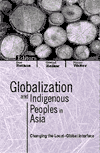| |
BOOK
REVIEW
First
nation tragedies
Globalization and Indigenous Peoples in
Asia, by Pierre Walter, Dev Nathan
and Govind Kelkar (ed)
Reviewed by Chanakya Sen
Professor Wangari Maathai's awarding of the
2004 Nobel Peace Prize is recognition of the
worldwide struggle of indigenous people to own
the forests that they manage and conserve for
the rest of humanity. The volume under review
reveals the processes whereby first nations in
China, India and Nepal are subjected to steady
 "resource
exclusion". It proposes changes in the
terms on which they interact with lowland
people and global markets. "resource
exclusion". It proposes changes in the
terms on which they interact with lowland
people and global markets.
First nation peoples are pivotal suppliers of
environmental (ecosystem) services like
climate control, biodiversity, soil nutrition
and clean water. Yet they are uncompensated
for producing these regional and global public
goods. Their cultural products and knowledge
are extracted free of charge by bio-pirates.
International environmental conventions and
state policies are restricting them from
accessing their livelihood opportunities and
displacing them from land ownership.
Globalization "increases further
marginalization, disempowerment and
desperation" (p 16) among hill-forest
dwellers.
Seventy percent of the world's aboriginals
live in Asia. They are characterized by high
poverty, low literacy, high malnutrition, low
life expectancy, high morbidity and low
human-rights. "Policies for the
indigenous peoples have so far been framed
with a view to the benefits that can be
extracted for the outside economies". (p
20) Victimized and socially isolated, bereft
of tenure and ownership rights over forests,
first nations suffer daily coercion.
Rapacious timber extraction and logging by
states and private companies are based on the
misplaced notion of forests as terra nullius,
land devoid of people. Land degeneration, soil
erosion, fertility depletion, landslides and
disappearance of non-timber forest products
are the results of clear-felling policies of
external actors. They have caused income
falls, urban migration and other uncompensated
losses to hill economies.
Dev Nathan's opening essay calls for an
acknowledgement of indigenous ownership of
forests, exercised as a combination of
communal and individual tenure. State command
and control approaches have to give way to an
incentive system involving pricing of
environmental services. Upland people should
be able to sell these services to the lowlands
as is being done in Costa Rica, Switzerland
and New York City. Lowlands should not be
allowed to benefit from upland services free
of cost, exacerbating the iniquities in living
standards between plains and mountain areas.
Sanjay Kumar's piece on indigenous know-how of
tribals in the eastern Indian state of
Jharkhand argues that their knowledge is not
only technical but also cultural and
sociological. Villagers know forests are
crucial for clean air and make conscious
efforts to protect tree species that are
pollution controllers. The role of forests in
hydrology (precipitation, rainfall and water
purification) is well understood and enhanced.
Trees useful as growth promoters of aquatic
food are carefully grown. Awareness of
moisture and nutrient flows from forests for
farmlands is passed down to new generations.
Forests are meticulously harnessed for storm
and pest protection functions too. The "cosmovision"
of indigenous people, manifested in elaborate
cultural events and beliefs, is tied to trees
and forests. Kumar calls for collating this
mine of local knowledge with dominant
Western-imported forestry management concepts.
Wang Qinghua's case study of the Hani in
China's Yunnan province illustrates the
important role of forests in terraced
agriculture. Locals appreciate forests as
natural green dams and disallow logging
through special regulations, watchmen and
punishments. Inorganic fertilizer use is
minimal. Hani women are experts in usage,
taste and properties of wild plants. A
socialized and "sacralized"
relationship with nature has allowed
regeneration of forests for centuries. Hani
traditional practices were dubbed
superstitious and eliminated during the Great
Leap Forward (1958) and Learn from Dazhai
Movement (1972). New policies after 1982 have
allowed reversion to low-impact uses of the
forest by the indigenous people.
Yu Xiaogang's article on the Yi and Naxi
people in Lijiang, Yunnan, portrays how
government projects seriously hurt first
nations. Benefits of so-called development and
environmental measures have flown to external
stakeholders, ie urban and downstream agrarian
areas. "Local people are getting
marginalized, since every decision that
affects them is made by outside centers".
(p 135) Intensive logging by the state has
left a destructive trail of soil erosion, lake
sedimentation, droughts and floods.
Uncontrolled private household logging is
another problem that the Yi and Naxi are
unable to check. Yu recommends embedding
decision-making in local hands as a component
of economic democracy.
Tiplut Nongbri discusses the disastrous
effects of the 1996 ban on tree felling and
all wood-based activities in northeast India.
It suddenly terminated livelihood sources for
the Khasi and Garo tribes of Meghalaya. To
escape starvation, they are now "descaling"
trees (removing and selling bark), migrating
to urban slums etc. The rural economy has
taken a steep downward slide, thanks to the
blanket proscription on access to forests. The
ban is an extension of draconian state power
and a demonstration of the erroneous
assumption that the state is the best guardian
of forests. A similar ban in China in 1998
choked local accumulation, put the brakes on
local development and deprived indigenous
people of the right to use their own
resources.
Dev Nathan's account of the large-scale
privatization of forests in northeast India is
a classic discourse on the pros and cons of
market-induced transformation of indigenous
economies. In the bid to maximize short-term
income, some indigenous people are
over-harvesting the "unregulated
commons" and under-providing
environmental services. Moneymaking by hook or
crook has gained respectability and there is a
concomitant attenuation of social obligations
to the needy. Collective action to maintain
forest quality and counter internal class
differentiation is much required.
Pierre Walter recounts the response of Hani
people to the explosive growth of tourism in
Xishuangbanna, Yunnan. In 1991, Hani of Manmo
village built a locally-managed eco-tourism
reserve, only for it to be appropriated for
"ethno-pilfering" by Han Chinese
entrepreneurs. The reserve is being employed
to propagate cultural images that satisfy Han
majority stereotypes and a "colonial
ranking of ethnicities". (p 216)
Eco-tourism has also deteriorated the gender
division of labor to the detriment of women.
Govind Kelkar's observations in Lijiang
corroborate the negativities for indigenous
women from tourism. Men, privileged with
external contacts and mobility, garner the
lion's portion of tourist income. Growth of
tourism is expanding male superiority even
among historically matrifocal communities.
Tourism-driven patriarchy can only be
neutralized if women are admitted to external
knowledge and resource management.
Girija Shrestha profiles the interesting
experiment in 10 districts of Nepal of
leaseholds to the poor as an incentive for
investment in currently degraded forests.
Leasing or auctioning of badly denuded forests
to the highest bidders do not address equity
concerns of women and the poor among first
nations. Nepalese Tamang, Praja and other
lowest castes have splendidly taken care of
the leases. The vegetative cover has improved
along with the productive base of the
impoverished. Women have the freedom to bypass
male-mediated access to forests. Asset
transfer, rather than the typical economist
prescription of income transfer, has been more
just.
N S Jodha explains why forest products are
facing export market problems. Presently,
costs of management of forests are not
reflected in pricing. Only the costs of
gathering are reflected. Food-insecure
first-nation producers are involved in an
unequal exchange with the rest of the world.
Monopsony in the buyer's market compounds the
under-pricing. Indigenous producers have to
form organizations to strengthen their
bargaining position and attain countervailing
market power. Capacity-building in organic
agriculture and other niche products can
enhance comparative advantage. Information
technology can bridge distances between
producers and markets and realize fairer
prices. "Knowledge-based workers"
are emerging among first nations in northern
Thailand and Kalimantan.
Integration of aboriginals into the global
economy has triggered civilizational changes.
The new organizing principles of society are
accumulation and wealth creation. Markets
benefit first nations by allowing higher
levels of income, consumption by choice and
efficiency in resource use. The flip side of
the coin is masculine domination and
inequalities in access to resources. Every
author in this book believes in restrictions
on property rights and non-market access when
it comes to critical natural resources. Public
intervention in privatization alone can
mitigate elite exploitation of the indigenes.
Globalization and Indigenous Peoples in
Asia, by Pierre Walter, Dev Nathan and
Govind Kelkar (ed). Sage Publications, New
Delhi, August 2004. ISBN: 0-7619-3253-4.
Price: US$15, 339 pages.
(Copyright 2004 Asia Times Online Ltd. All
rights reserved. Please contact [email protected]
for information on our sales and syndication
policies.) |
| |
|
|
 |
|




 "resource
exclusion". It proposes changes in the
terms on which they interact with lowland
people and global markets.
"resource
exclusion". It proposes changes in the
terms on which they interact with lowland
people and global markets.


